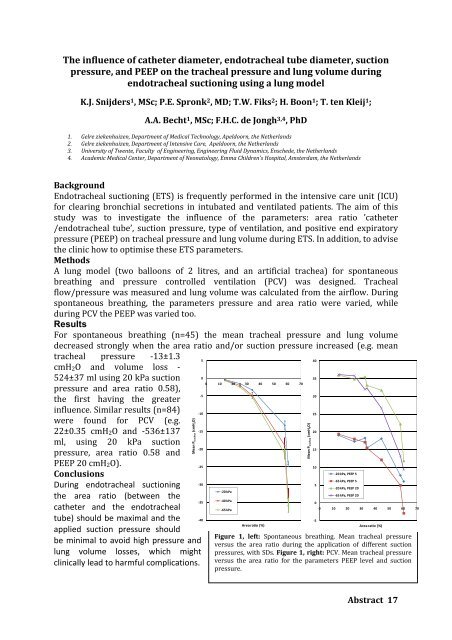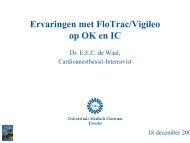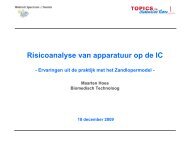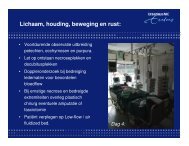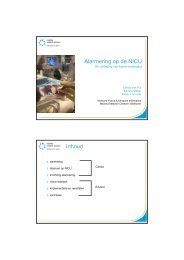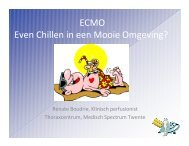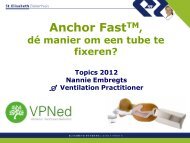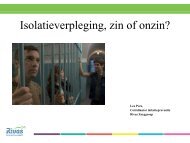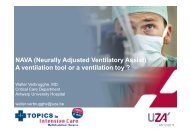Abstract 1 - Topics in Intensive Care
Abstract 1 - Topics in Intensive Care
Abstract 1 - Topics in Intensive Care
You also want an ePaper? Increase the reach of your titles
YUMPU automatically turns print PDFs into web optimized ePapers that Google loves.
The <strong>in</strong>fluence of catheter diameter, endotracheal tube diameter, suction<br />
pressure, and PEEP on the tracheal pressure and lung volume dur<strong>in</strong>g<br />
endotracheal suction<strong>in</strong>g us<strong>in</strong>g a lung model<br />
K.J. Snijders 1 , MSc; P.E. Spronk 2 , MD; T.W. Fiks 2 ; H. Boon 1 ; T. ten Kleij 1 ;<br />
A.A. Becht 1 , MSc; F.H.C. de Jongh 3,4 , PhD<br />
1. Gelre ziekenhuizen, Department of Medical Technology, Apeldoorn, the Netherlands<br />
2. Gelre ziekenhuizen, Department of <strong>Intensive</strong> <strong>Care</strong>, Apeldoorn, the Netherlands<br />
3. University of Twente, Faculty of Eng<strong>in</strong>eer<strong>in</strong>g, Eng<strong>in</strong>eer<strong>in</strong>g Fluid Dynamics, Enschede, the Netherlands<br />
4. Academic Medical Center, Department of Neonatology, Emma Children's Hospital, Amsterdam, the Netherlands<br />
Background<br />
Endotracheal suction<strong>in</strong>g (ETS) is frequently performed <strong>in</strong> the <strong>in</strong>tensive care unit (ICU)<br />
for clear<strong>in</strong>g bronchial secretions <strong>in</strong> <strong>in</strong>tubated and ventilated patients. The aim of this<br />
study was to <strong>in</strong>vestigate the <strong>in</strong>fluence of the parameters: area ratio ’catheter<br />
/endotracheal tube’, suction pressure, type of ventilation, and positive end expiratory<br />
pressure (PEEP) on tracheal pressure and lung volume dur<strong>in</strong>g ETS. In addition, to advise<br />
the cl<strong>in</strong>ic how to optimise these ETS parameters.<br />
Methods<br />
A lung model (two balloons of 2 litres, and an artificial trachea) for spontaneous<br />
breath<strong>in</strong>g and pressure controlled ventilation (PCV) was designed. Tracheal<br />
flow/pressure was measured and lung volume was calculated from the airflow. Dur<strong>in</strong>g<br />
spontaneous breath<strong>in</strong>g, the parameters pressure and area ratio were varied, while<br />
dur<strong>in</strong>g PCV the PEEP was varied too.<br />
Results<br />
For spontaneous breath<strong>in</strong>g (n=45) the mean tracheal pressure and lung volume<br />
decreased strongly when the area ratio and/or suction pressure <strong>in</strong>creased (e.g. mean<br />
tracheal pressure ‐13±1.3<br />
cmH2O and volume loss ‐<br />
524±37 ml us<strong>in</strong>g 20 kPa suction<br />
pressure and area ratio 0.58),<br />
the first hav<strong>in</strong>g the greater<br />
<strong>in</strong>fluence. Similar results (n=84)<br />
were found for PCV (e.g.<br />
22±0.35 cmH2O and ‐536±137<br />
ml, us<strong>in</strong>g 20 kPa suction<br />
pressure, area ratio 0.58 and<br />
PEEP 20 cmH2O).<br />
Conclusions<br />
Dur<strong>in</strong>g endotracheal suction<strong>in</strong>g<br />
the area ratio (between the<br />
catheter and the endotracheal<br />
tube) should be maximal and the<br />
applied suction pressure should<br />
be m<strong>in</strong>imal to avoid high pressure and<br />
lung volume losses, which might<br />
cl<strong>in</strong>ically lead to harmful complications.<br />
Mean P trachea (cmH 2O)<br />
5<br />
0<br />
‐5<br />
‐10<br />
‐15<br />
‐20<br />
‐25<br />
‐30<br />
‐35<br />
‐40<br />
0 10 20 30 40 50 60 70<br />
‐20 kPa<br />
‐40 kPa<br />
‐65 kPa<br />
Area ratio (%)<br />
Mean P trachea (cmH2O)<br />
40<br />
35<br />
30<br />
25<br />
20<br />
15<br />
10<br />
Figure 1, left: Spontaneous breath<strong>in</strong>g. Mean tracheal pressure<br />
versus the area ratio dur<strong>in</strong>g the application of different suction<br />
pressures, with SDs. Figure 1, right: PCV. Mean tracheal pressure<br />
versus the area ratio for the parameters PEEP level and suction<br />
pressure.<br />
5<br />
0<br />
‐5<br />
‐20 kPa, PEEP 5<br />
‐65 kPa, PEEP 5<br />
‐20 kPa, PEEP 20<br />
‐65 kPa, PEEP 20<br />
0 10 20 30 40 50 60 70<br />
Area ratio (%)<br />
<strong>Abstract</strong> 17


